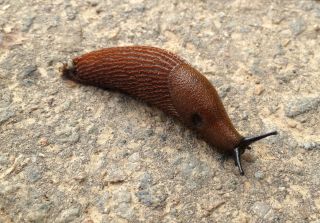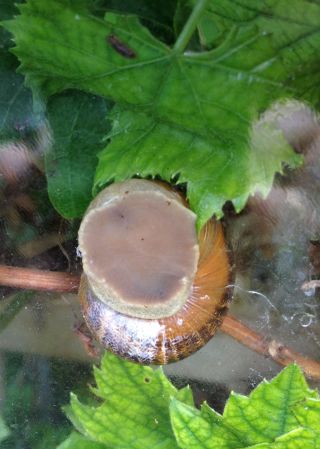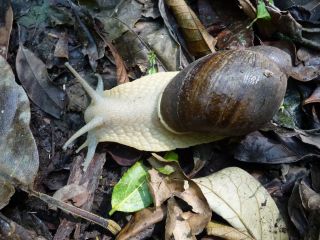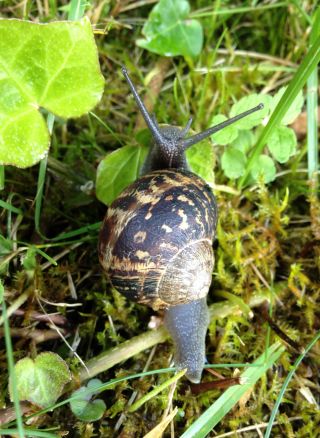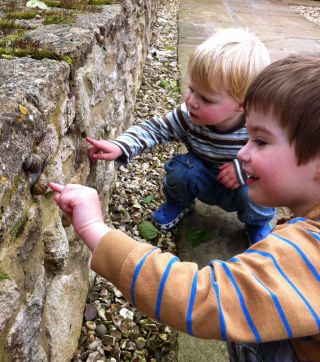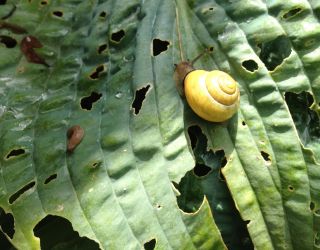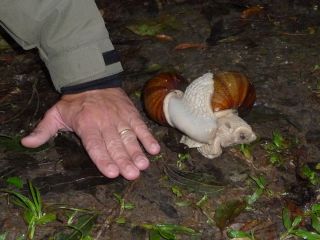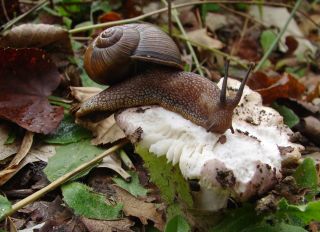Hungry sole: A brown slug, which eats — like snails — through a mouth in its foot.
Slugs, snails and astonishing tales
By Mark Brazil | Jul 15, 2012
Late last month, I arrived at my friends’ house in the historic southwest English town of Stroud a little too early, only to find both Ian and Caroline Redmond out. So, with time on my hands, I wandered into their lovely garden on the slope of a hill overlooking the town and began to “potter about.”For some reason I was drawn to a damp corner, where I noticed a distinct change in the vegetation — it was all riddled with holes ! Every plant had been perforated until the leaves resembled Swiss cheese. I soon apprehended the culprits and realized I was in Gastropoda heaven — it was a slug fest and there were slugs and snails everywhere.
If the world were ruled with reference to its largest groups of species, rather than being driven by human populations and geopolitical factors, then insects would occupy the greatest block of seats on any governing council. Then the next-largest block would go to the 611 families of gastropods, representing some 60,000 to 80,000 living species of snails and slugs.
Even birds, with some 10,000 species, would be twice as well represented as our own class — that being the mammals — which boasts a mere 5,000 species.
As just one species of mammal we would be huddled in a corner of that governing council, not even assigned a seat and feeling insignificant, overlooked and unheard.
Though we typically view the world through complex mammalian eyes, to see it as most creatures on Earth view it, we should regard it through the marvelously compound eyes of many of the insects — or the simple pit eyes of many of the gastropods.
The world is, in fact, dominated by vast numbers of species of bugs, slugs and snails — to many of which many humans react with just one word: “Yuck !”
We can cram so much disdain into a word, yet it’s hardly fair. After all, gastropods ranging in size from the microscopic to the monstrous survive successfully and abundantly in an astonishingly diverse array of habitats, from lowland woods to mountain tops and deserts; in freshwater and salt water; and from the rocky intertidal zone to oceanic hotspots and abyssal depths — even in hydrothermal vents.
Gastropods also do very well in my friends’ garden ! Poring over the plants and walling of that damp corner, within just 15 minutes I recognized nine species of slugs and snails — more than the number of bird species I’d seen or heard that day. In fact, so absorbed was I in that gastropod menagerie that I didn’t notice the arrival of my biologist and conservationist friend, Ian Redmond OBE, until he called out to me.
A gastropod’s lifestyle differs so much from ours that it is hard to coceptualize, but try this: Lie down on the floor and imagine first that you have no bones, that you have but one foot and that it runs the entire length of your body. Imagine that your foot is “you,” and that everything else is reduced and your head is now attached to one end of your massive muscular foot. Instead of the familiar two eyes, two ears and a nose, your face has now morphed into four flexible tentacles with which you can sample your environment, sensing light and dark, flavors and odors. If you are a snail, then strapped on top of your foot is your house that grows with your body, your shell, but you carry nothing if you are a slug. Now imagine that your mouth is beneath your head, under your foot, so that as you slide along you can feed on anything beneath you.
The strange term gastropod means, literally, “stomach footed.” Mostly, gastropods graze on living plants, especially on their leaves; they also feed on fungi. Some of them scavenge and will feed on dead animal matter. And just as some snakes have specialized as hunters of other snakes, assassin snails hunt down other species and consume them. All of them ingest their food — or prey — by means of what is known as a radula, which is somewhat tongue-like, but with rows of tiny rasping teeth that feed food into the mouth in the foot.
The slugs and snails I found in Ian’s garden, and the many I encounter while hiking in damp forests here in Japan, were leaving behind characteristic evidence of their passage — slime trails.
One of the most crucial abilities of land-based gastropods is to produce mucus beneath their foot, on which they can slide along. In doing so they leave their telltale, silvery trails that steadily dry behind them. Their susceptibility to drying is what drives many snail species to overwinter (hibernate) or oversummer (aestivate) inside their shells. They retreat there, sealing themselves in, so avoiding further moisture loss until conditions suit them.
It is the fondness of many gastropod species for damp places that makes such corners in gardens so irresistible to them. As they move along, they wave their tentacles in front, sensing their environment and seeking food, but if you bend down and peer closely at one with a hand lens, or make a move to touch it, then those tentacles are as likely as not going to signal a retreat. First they shrink in upon themselves, then the whole creature retracts, and if it’s a snail it retreats back into its shell until it feels that disturbance is over.
If what disturbs it is not the probing finger of an excited child, or a naturalist, but another slug or snail of the same species, then matters may proceed very differently.
In this case the romantic gastropods may spend hours in courtship, first tentatively touching tentacles and sensing, then engaging more (how shall I put this?) — moistly. At this stage of their relationship they flow onto and around each other, writhing in slow motion in pursuit of a common goal — as I recently observed in Brazil between two of the largest snails I have ever encountered.
As part of the mating process, excited snails vie to fire love darts into each other, akin to being stabbed at close range with an arrow. These darts carry hormones that are involved in the reproductive process, and their firing is a precursor to copulation and sperm exchange.
Most terrestrial gastropods are hermaphrodites — that is, each one carries complete male and female reproductive organs, and during copulation each inseminates the other. Both may then go on to produce eggs that they bury beneath leaf litter or in soft soil.
These curious creatures range in size from ones so small they can slither through the eye of a needle, to some so large that just one would more than cover your hand. The largest of the enormous, carnivorous Powelliphanta snails of New Zealand span 9 cm and weigh up to 90 grams. However, the grand champion of the terrestrial snail world is the African Giant Snail of Ghana, whose shell can grow to 18 cm in length.
Meanwhile, the world’s largest slugs can reach more than 25 cm in length and weigh more than 100 grams — and the largest in Japan may reach the size of a small banana !
Unfortunately, giant snails from Africa were introduced into Okinawa, Amami Island and the Ogasawara Islands during the early 20th century as a possible food source, but now they are an established invasive species doing untold damage to the ecological balance.
Many marine gastropods such as whelks, abalone and limpets feature in the human diet, and in some European and African countries, terrestrial gastropods are also important food. They are delicacies in French, Spanish and Portuguese cuisine, and collecting them from the wild is not enough to satisfy the demand. As a result, the wonderfully named heliciculture is practiced — in other words, they are farmed.
Human introduction is not the only means by which slugs and snails can reach isolated islands such as ones in Britain or Japan. Gastropods’ small sticky eggs can be carried glued to the feet or feathers of birds during their movements and migrations — which accounts for their appearance early in the development of ecosystems on new or newly cauterized islands.
Sir Charles Lyell (1797-1875), the revolutionary English geologist who prompted and prodded Charles Darwin, and whose work also influenced Alfred Russell Wallace — best known for independently proposing a theory of evolution due to natural selection that prompted Darwin to publish his own theory — was absorbed by, among other things, the distributions of snails on isolated islands, and the similarities and differences between those of archipelagoes such as Britain and nearby land masses such as Europe.
Japan, like Britain, is a fascinating realm for terrestrial gastropods. With its wide range of ecosystems from sub-tropical to boreal, its plentiful rainfall, myriad streams and abundance of damp habitats, this country is a great place to get down and dirty and seek out where those slime trails may lead.

